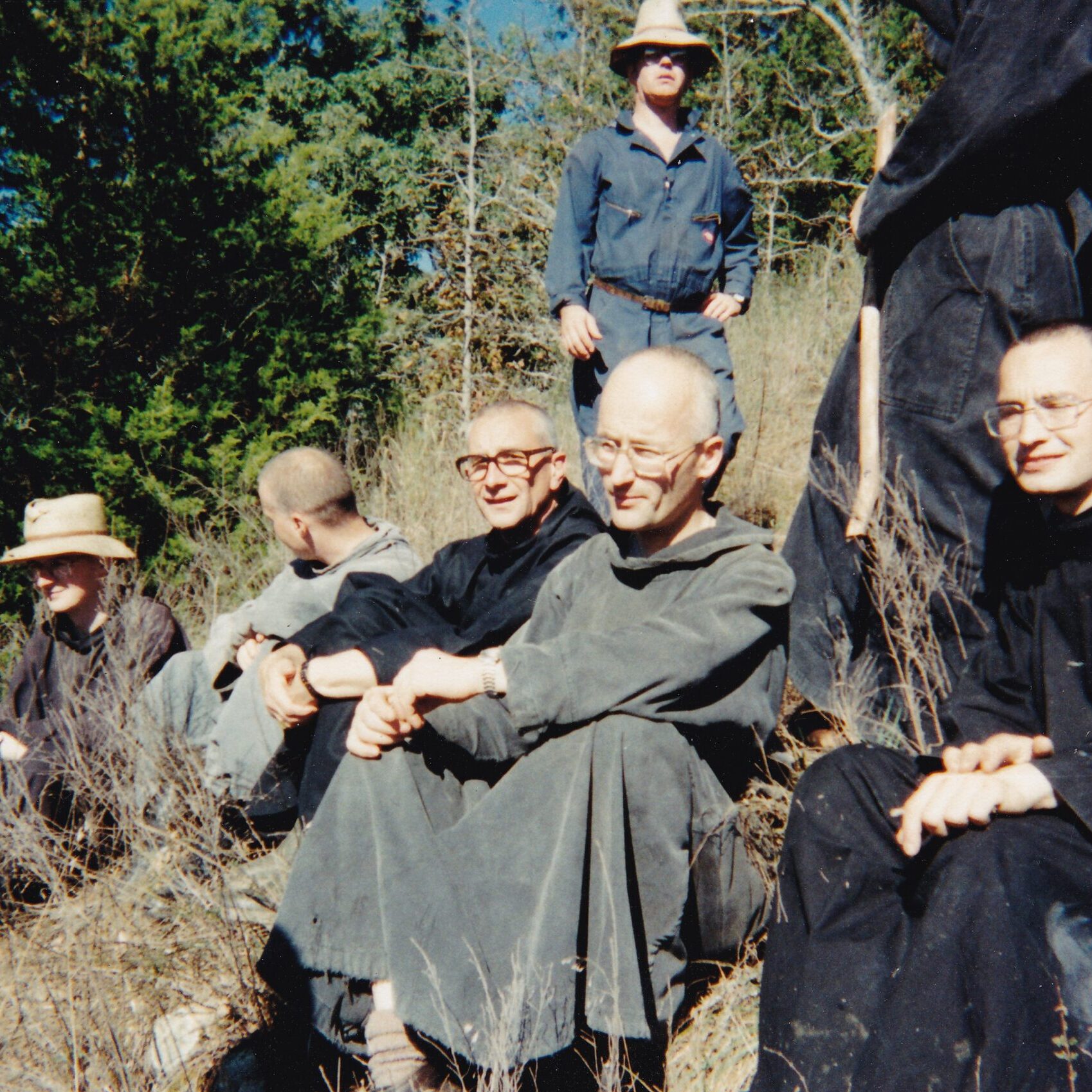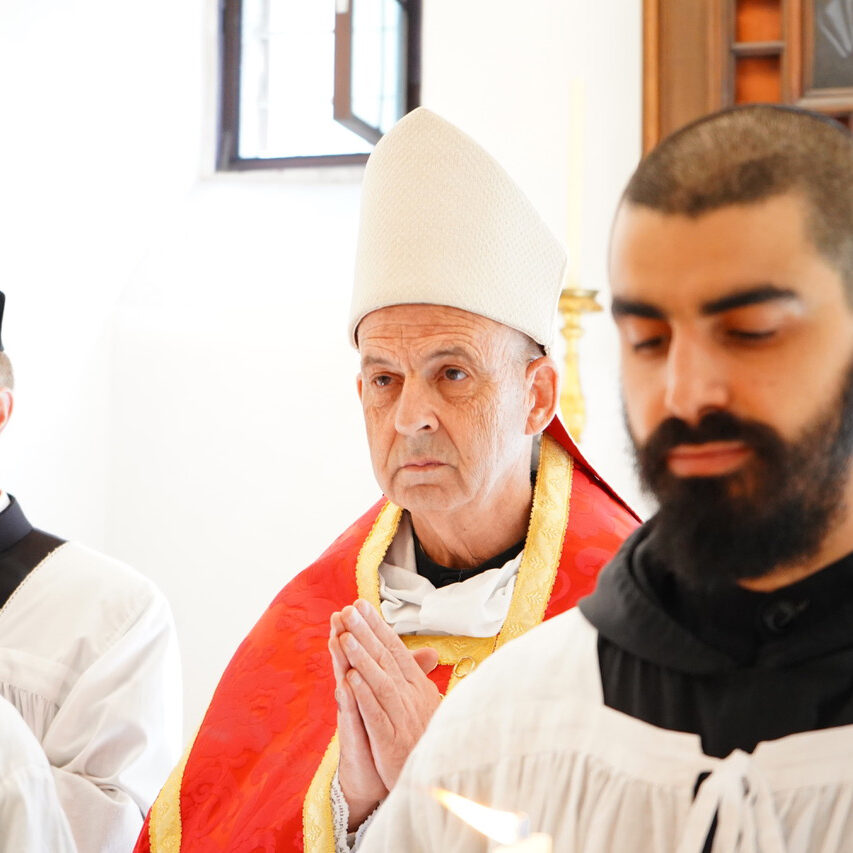The print version of this letter includes additional images and explanations.
Dear Friend of Clear Creek Abbey,
Many of you have followed with interest the founding of Clear Creek Abbey from the very beginning in 1999. You know that the history of our abbey has been closely linked to the history of our construction projects. From the beginning we stated that we intended to ‘build something beautiful for God’ and that we wanted to construct a monastery ‘to last a thousand years.’ It is a simple fact that the Benedictine monks, whose history scans some fifteen centuries, have been audacious builders. Even a casual glance at the architectural history of Europe will bear this out. Although America is not Europe, although we must, of course, adapt to place and time, nevertheless it has always been our mind—even now—that Clear Creek should be the site of a true Benedictine abbey, one that would fit into both the spiritual and the architectural traditions of the black monks down through the ages.
In this ongoing “story of a construction site” the time has come, I believe, to make a concerted effort to complete that essential piece of the monastery buildings which is the church. The portion already constructed is a most encouraging promise of what the future will hold. The rhythm of the pillars and arches, the harmonious proportions, and the beautiful acoustics for chanting have already won us over. Nevertheless, the edifice remains quite incomplete. There are obvious drawbacks to living in an unfinished building, one without insulation, one that cannot be heated in winter or kept reasonably cool in summer. The promise of the beginning calls for the consummation of the thing so well begun. Furthermore, the effort to bring to completion the church will represent a decisive step in completing Our Lady of Clear Creek Abbey as a whole. Only a completed church can receive the incomparable grace which is the Dedication of the church. Will you help us?
Why Build Like That?
It could be argued that in our day and age the construction of large buildings is excessively costly and not in keeping with a more modern approach to monastic life. Do we really need to encumber the landscape with another “white elephant”—a throwback to the triumphalism of the Neo-Gothic structures of the 19th and 20th centuries? Modern technology has provided more efficient and cost-effective ways of building. So goes a certain modern criticism. But as many commentators have pointed out, the practical but inharmonious boxes of metal and glass we perceive as truly contemporary do not inspire human beings to lift up their souls to God. It is not just a matter of being contemporary, but rather of having buildings that fulfill a purpose—even a vocation. The liturgical emphasis of our Benedictine spirituality sets the tone here. A certain space and beauty are necessary to experiencing more fully what St. Benedict calls the “Work of God.” It is entirely possible that what the Church—and even the world—needs most right now is precisely that wellspring of meaning and life that emanates from the Work of God, celebrated in a well suited church.
Another avenue of the same criticism points to the seeming absurdity of men vowed to evangelical poverty raising millions of dollars to construct elaborate buildings. Historically speaking there have been different modes of evangelical poverty, some excluding all architectural display. But even the strictest forms allow for magnificence in those places assigned to divine worship. When it came to decorating his parish church, the saintly (and very poor) Cure of Ars did not hesitate to purchase costly materials. Some call this the “luxury for God”. It is true that God is present in the smallest, poorest chapel, but after two millennia of Christian civilization it is obvious that God wants large churches too, especially when they inspire the faith of generations of Christ’s faithful, especially when they lift up the souls of the poor themselves.
With God’s Help We Can Make It Happen.
We are aware of the challenges that we face in moving forward to complete our abbatial church at this time. But we believe in prayer which is why we are praying a Novena to St. Joseph from October 3rd through October 11th. Please join us in imploring the assistance of God for this great endeavor, through the intercession of Our Lady of the Annunciation (our Patroness) and of St. Joseph. He has never failed us in the past in these material necessities. (Please see the St. Joseph Novena below.)
Thank you and please know you are ever in our remembrance before God.
br. Philip Anderson, abbot of Our Lady of Clear Creek
Story of a Work Site:
2001: Architect Thomas Gordon Smith is hired; elaboration of first building plans.
2003: Completion of road to new monastery and of stone bridge over Clear Creek. Foundations poured for residence and church (lower level, crypt).
2007: Completion of residence building.
2008: Monks move into new monastery; gatehouse completed; Bishop Slattery blesses new monastery.
2010: Brick veneer of crypt and finishing of inside of crypt completed.
2011: Construction of the church’s west façade, nave, and transept to half their intended height; temporary roof for the church completed.
2013: Schematic architectural plans for remaining buildings, including chapter house, refectory, and library completed.
The print version of this letter includes additional images and explanations.
Dear Friend of Clear Creek Abbey,
Many of you have followed with interest the founding of Clear Creek Abbey from the very beginning in 1999. You know that the history of our abbey has been closely linked to the history of our construction projects. From the beginning we stated that we intended to ‘build something beautiful for God’ and that we wanted to construct a monastery ‘to last a thousand years.’ It is a simple fact that the Benedictine monks, whose history scans some fifteen centuries, have been audacious builders. Even a casual glance at the architectural history of Europe will bear this out. Although America is not Europe, although we must, of course, adapt to place and time, nevertheless it has always been our mind—even now—that Clear Creek should be the site of a true Benedictine abbey, one that would fit into both the spiritual and the architectural traditions of the black monks down through the ages.
In this ongoing “story of a construction site” the time has come, I believe, to make a concerted effort to complete that essential piece of the monastery buildings which is the church. The portion already constructed is a most encouraging promise of what the future will hold. The rhythm of the pillars and arches, the harmonious proportions, and the beautiful acoustics for chanting have already won us over. Nevertheless, the edifice remains quite incomplete. There are obvious drawbacks to living in an unfinished building, one without insulation, one that cannot be heated in winter or kept reasonably cool in summer. The promise of the beginning calls for the consummation of the thing so well begun. Furthermore, the effort to bring to completion the church will represent a decisive step in completing Our Lady of Clear Creek Abbey as a whole. Only a completed church can receive the incomparable grace which is the Dedication of the church. Will you help us?
Why Build Like That?
It could be argued that in our day and age the construction of large buildings is excessively costly and not in keeping with a more modern approach to monastic life. Do we really need to encumber the landscape with another “white elephant”—a throwback to the triumphalism of the Neo-Gothic structures of the 19th and 20th centuries? Modern technology has provided more efficient and cost-effective ways of building. So goes a certain modern criticism. But as many commentators have pointed out, the practical but inharmonious boxes of metal and glass we perceive as truly contemporary do not inspire human beings to lift up their souls to God. It is not just a matter of being contemporary, but rather of having buildings that fulfill a purpose—even a vocation. The liturgical emphasis of our Benedictine spirituality sets the tone here. A certain space and beauty are necessary to experiencing more fully what St. Benedict calls the “Work of God.” It is entirely possible that what the Church—and even the world—needs most right now is precisely that wellspring of meaning and life that emanates from the Work of God, celebrated in a well suited church.
Another avenue of the same criticism points to the seeming absurdity of men vowed to evangelical poverty raising millions of dollars to construct elaborate buildings. Historically speaking there have been different modes of evangelical poverty, some excluding all architectural display. But even the strictest forms allow for magnificence in those places assigned to divine worship. When it came to decorating his parish church, the saintly (and very poor) Cure of Ars did not hesitate to purchase costly materials. Some call this the “luxury for God”. It is true that God is present in the smallest, poorest chapel, but after two millennia of Christian civilization it is obvious that God wants large churches too, especially when they inspire the faith of generations of Christ’s faithful, especially when they lift up the souls of the poor themselves.
With God’s Help We Can Make It Happen.
We are aware of the challenges that we face in moving forward to complete our abbatial church at this time. But we believe in prayer which is why we are praying a Novena to St. Joseph from October 3rd through October 11th. Please join us in imploring the assistance of God for this great endeavor, through the intercession of Our Lady of the Annunciation (our Patroness) and of St. Joseph. He has never failed us in the past in these material necessities. (Please see the St. Joseph Novena below.)
Thank you and please know you are ever in our remembrance before God.
br. Philip Anderson, abbot of Our Lady of Clear Creek
Story of a Work Site:
2001: Architect Thomas Gordon Smith is hired; elaboration of first building plans.
2003: Completion of road to new monastery and of stone bridge over Clear Creek. Foundations poured for residence and church (lower level, crypt).
2007: Completion of residence building.
2008: Monks move into new monastery; gatehouse completed; Bishop Slattery blesses new monastery.
2010: Brick veneer of crypt and finishing of inside of crypt completed.
2011: Construction of the church’s west façade, nave, and transept to half their intended height; temporary roof for the church completed.
2013: Schematic architectural plans for remaining buildings, including chapter house, refectory, and library completed.






